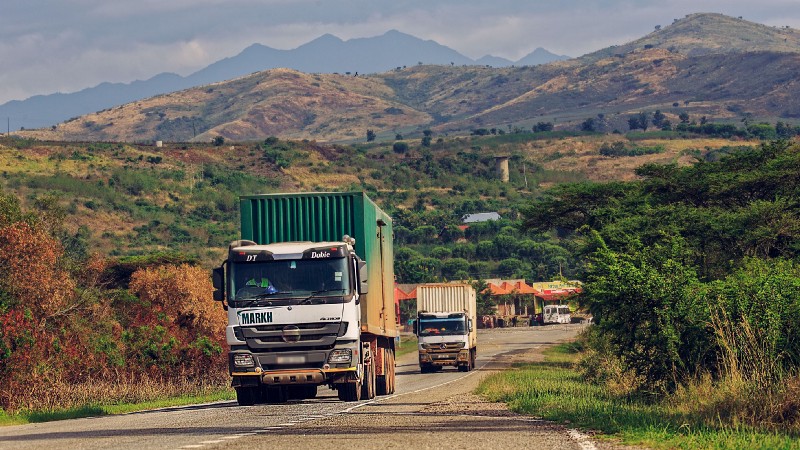
Transportation systems are evolving quickly across East Africa. New technologies are creating new opportunities for cities and countries to participate in the global economy.
These opportunities are of key importance, especially to landlocked countries (countries with no direct access to international waters or global trade through a seaport.)
Landlocked countries pay a high price for not having a seaport of their own.
Their trade almost always must transit through other countries — a process that involves dealing with inadequate transport infrastructure of neighboring countries.
However, the trade barriers that they experience are related to more than just the physical transport of goods and services.
Non-physical factors such as customs procedures and border crossing play an increasingly important role in determining the competitiveness of a country’s trade.
Despite the prevailing challenges landlocked countries face, their inland location presents several opportunities too. They can become regional hubs for manufacturing, infrastructure, and service provision.
Rwanda is one such example. The country has quickly become one of Africa’s fastest-growing economies despite its geographical disadvantage.
Unique Logistical Challenges That The Landlocked Countries Of East Africa Face
Landlocked countries face a myriad of challenges with connectivity and transportation.
Each landlocked country faces challenges stemming from its unique history and geography but together, they face the common issue of how to connect to the global economy.
Their remoteness from major world markets is the principal reason why many landlocked countries in East Africa have had less success in mitigating the consequences caused by their geographical handicap as compared to landlocked countries in Europe, for example.
European landlocked countries are surrounded by developed markets so these countries don’t majorly depend on countries that are oceans away to bring in goods. Their seaborne trade accounts for a relatively small part of their external trade.
This, therefore, reduces their dependence on the seaports of their neighbors, unlike in EA where the majority of goods must travel to our countries through the ocean.
Some of the challenges experienced by East African landlocked countries include:
1. Goods take longer to exit ports
Bottlenecks in neighboring countries’ ports, not road quality, are the main reason for trade logistics issues in landlocked countries.
Goods destined for landlocked countries sit longer in ports than domestically bound goods.
Goods bound for Uganda, Rwanda, and Burundi spend more days in Tanzania’s Dar Es Salaam port than domestically bound goods. The same is true for goods shipped through the Port of Mombasa.
Goods bound for landlocked countries face at least three “clearance” processes, while coastal countries face only one.
The first clearance point is at the port. The second happens at the borders. A final delay occurs when goods are finally cleared in the capital city in the landlocked country.
2. Complete dependence on the physical & trade infrastructure of transit countries
The most obvious challenge that landlocked countries face is that they do not have access to the ocean, and therefore cannot through their efforts alone, improve infrastructure and access to global trade.
With international trade largely dependent on other transit countries (countries with seaports), they face not only longer land distances from global markets, but also the need to develop cordial relationships with their neighbors to reduce transaction costs in terms of money and time at borders, both for the import and export of raw materials and products.
3. Inefficient border crossings
Some landlocked countries of East Africa also suffer from weak border infrastructure for processing and clearing shipments.
Disorganized cross-border transit sometimes means that goods can be held up at the border for days or even weeks.
This means that goods might get spoiled, and as a result, traders must keep more goods in inventory than perhaps necessary. This directly drives up costs to consumers.
Inefficient borders have broad impacts on economies and transportation. If truck drivers are not able to efficiently deliver their goods and are stuck at the borders, they cannot make money by making more trips.
As a result, they resort to overloading and charging higher fees per trip. Higher fees are passed on directly to consumers through higher prices.
4. Trucking cartels
Landlocked countries could also face the issue of criminal monopolies or syndicates at their borders.
These illegal organizations can raise prices on freight services and fuel indiscriminately to the detriment of society, particularly in places where land border infrastructure is not properly configured to reduce traffic (such as with dry ports away from borders), or where electronic customs procedures are not in place.
This makes rent-seeking from drivers easier when processing border documents far away from central government eyes.
5. Ever-increasing transportation costs
Additional border crossings and long distances from major markets, coupled with cumbersome transit procedures and inadequate infrastructure, substantially increase the total expenses for transport costs, eroding the competitive edge of landlocked countries.
This reduces economic growth and subsequently negatively affects their capacity to promote sustained economic development, human and social progress.
As a result, being landlocked is a major contributor to the relatively high incidence of extreme poverty and structural constraints in landlocked developing countries.
In Conclusion,
Landlocked countries usually try to mitigate their lack of accessibility to global trade by developing transport corridors towards maritime gateways. The LAPSSet project is one good example.
Rail and road corridors are the most effective freight services towards landlocked countries can be established.
Landlocked countries also mitigate the complexities of accessibility to global trade by building Free Trade Areas (FTAs.)
There also are no specific connectivity barriers for landlocked countries to access air transportation. For example, Botswana is heavily reliant on air transportation to export its diamonds to the western world.
Still, landlocked countries tend to be less connected because of their lower levels of development.

